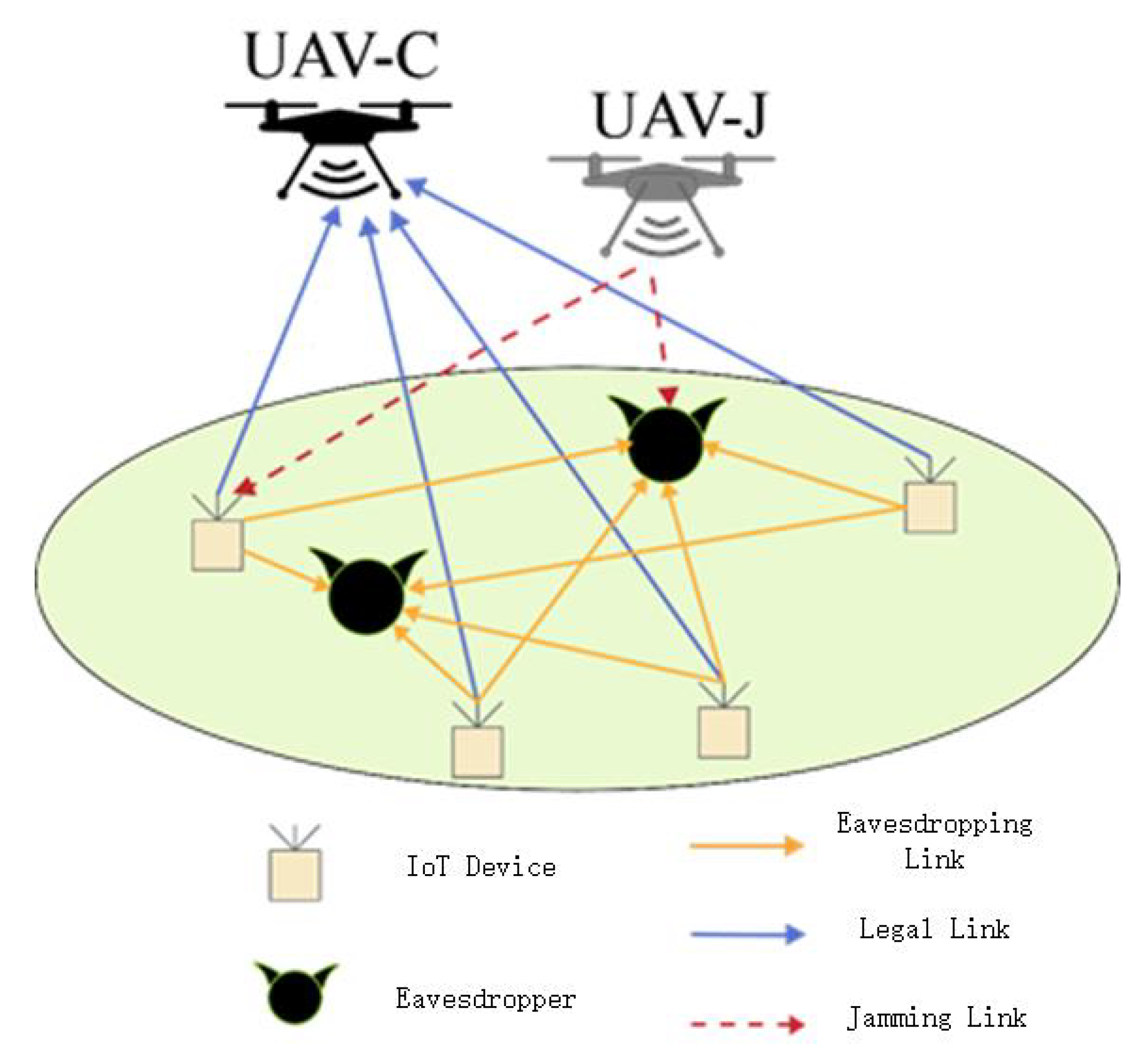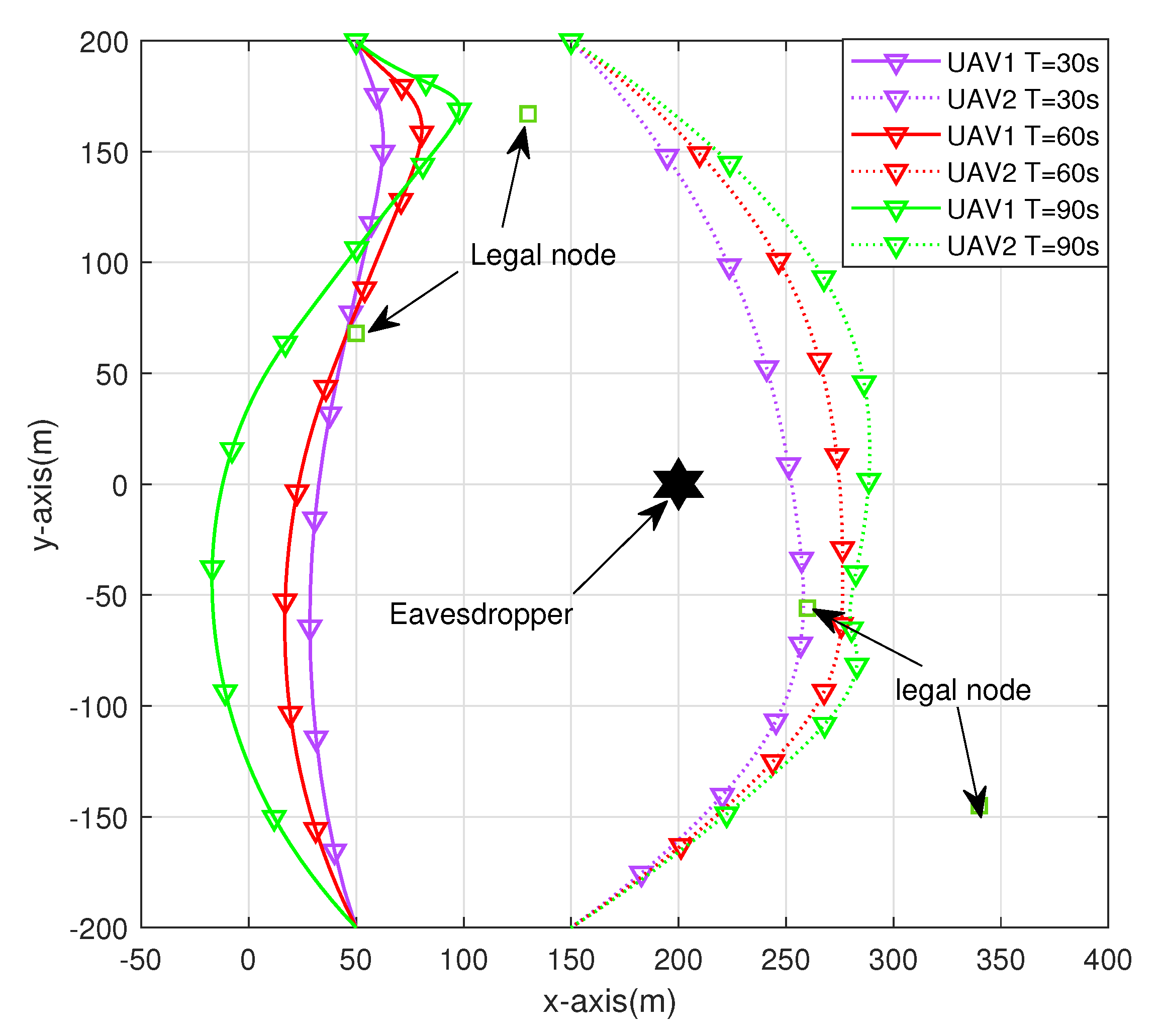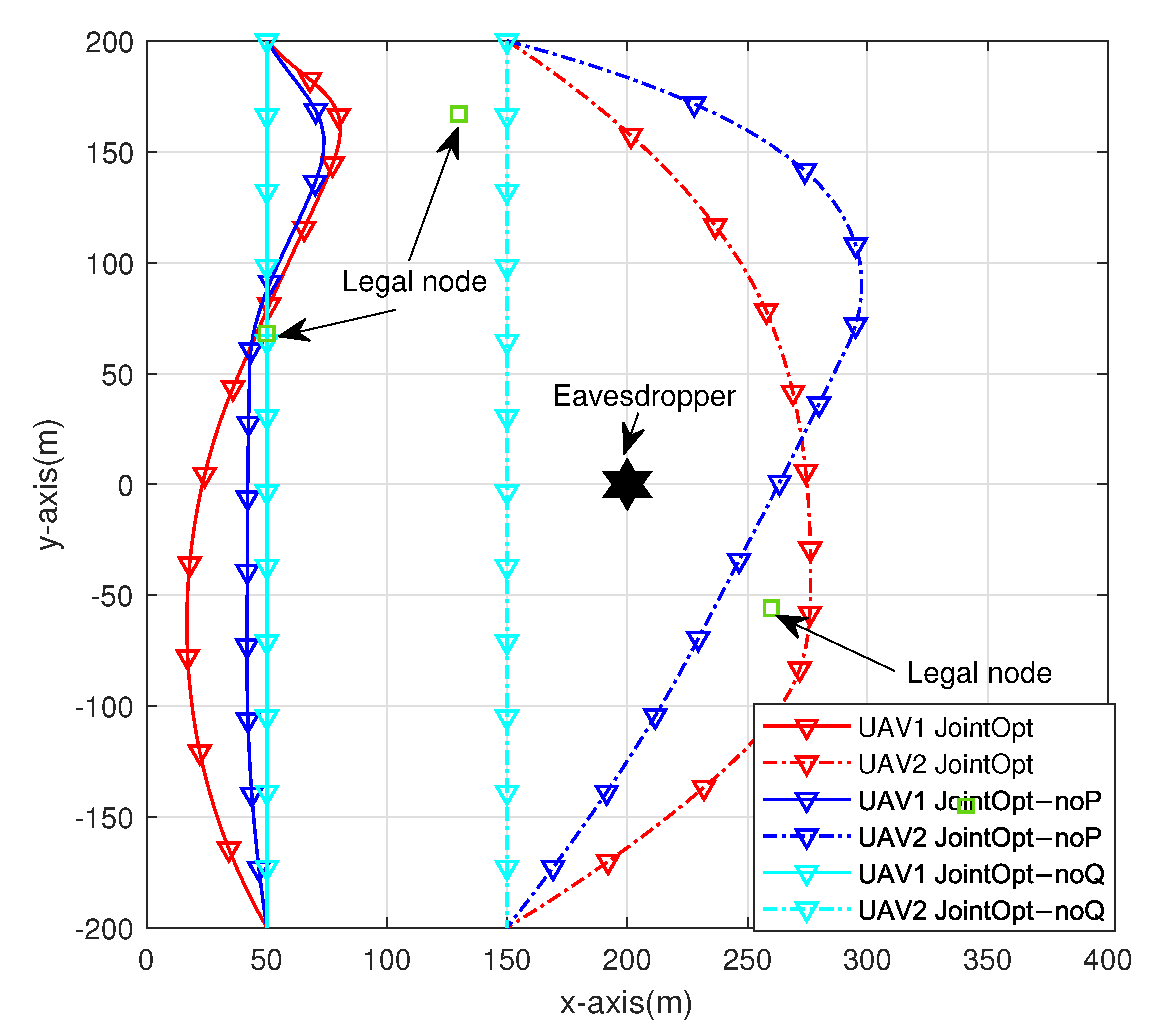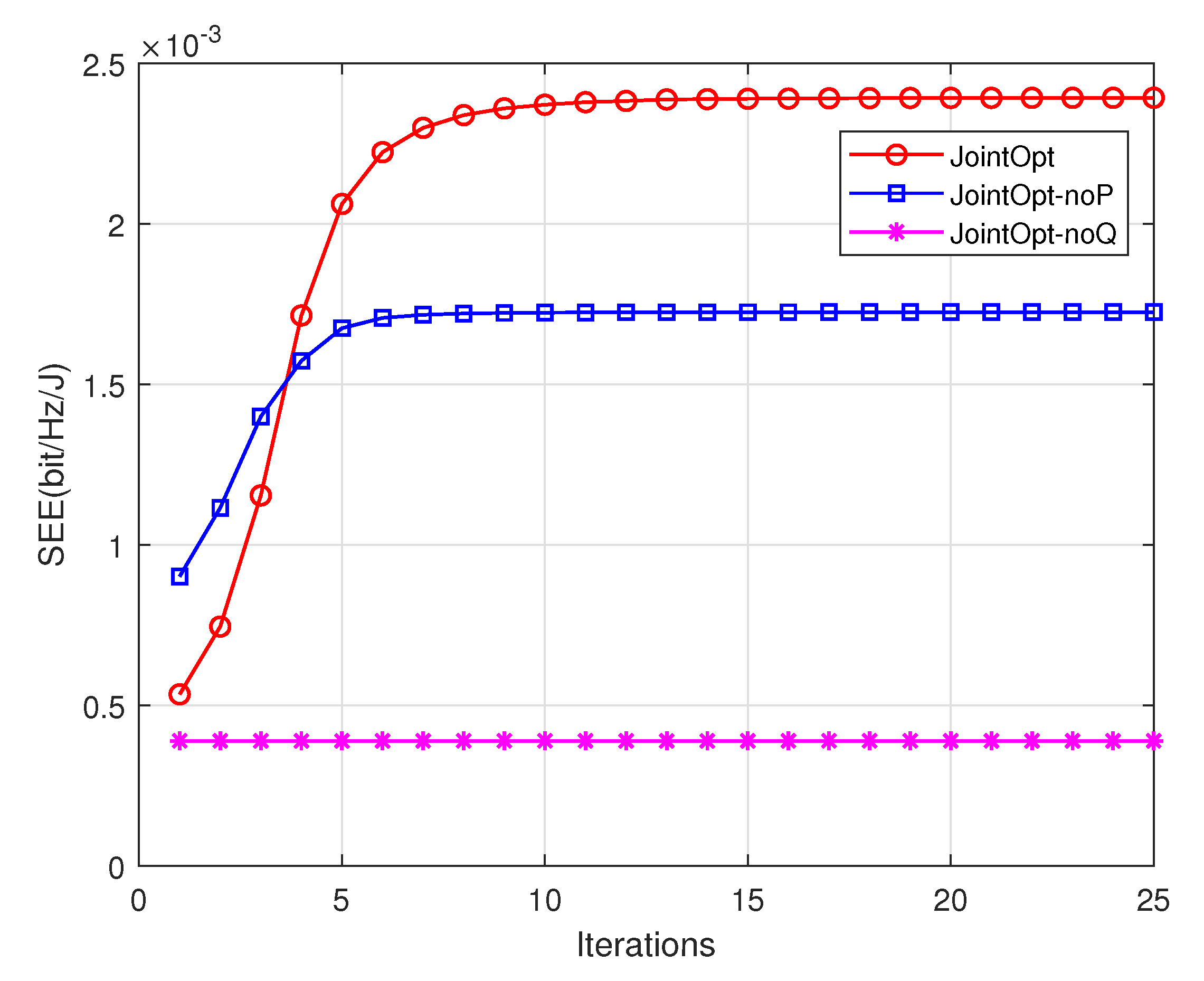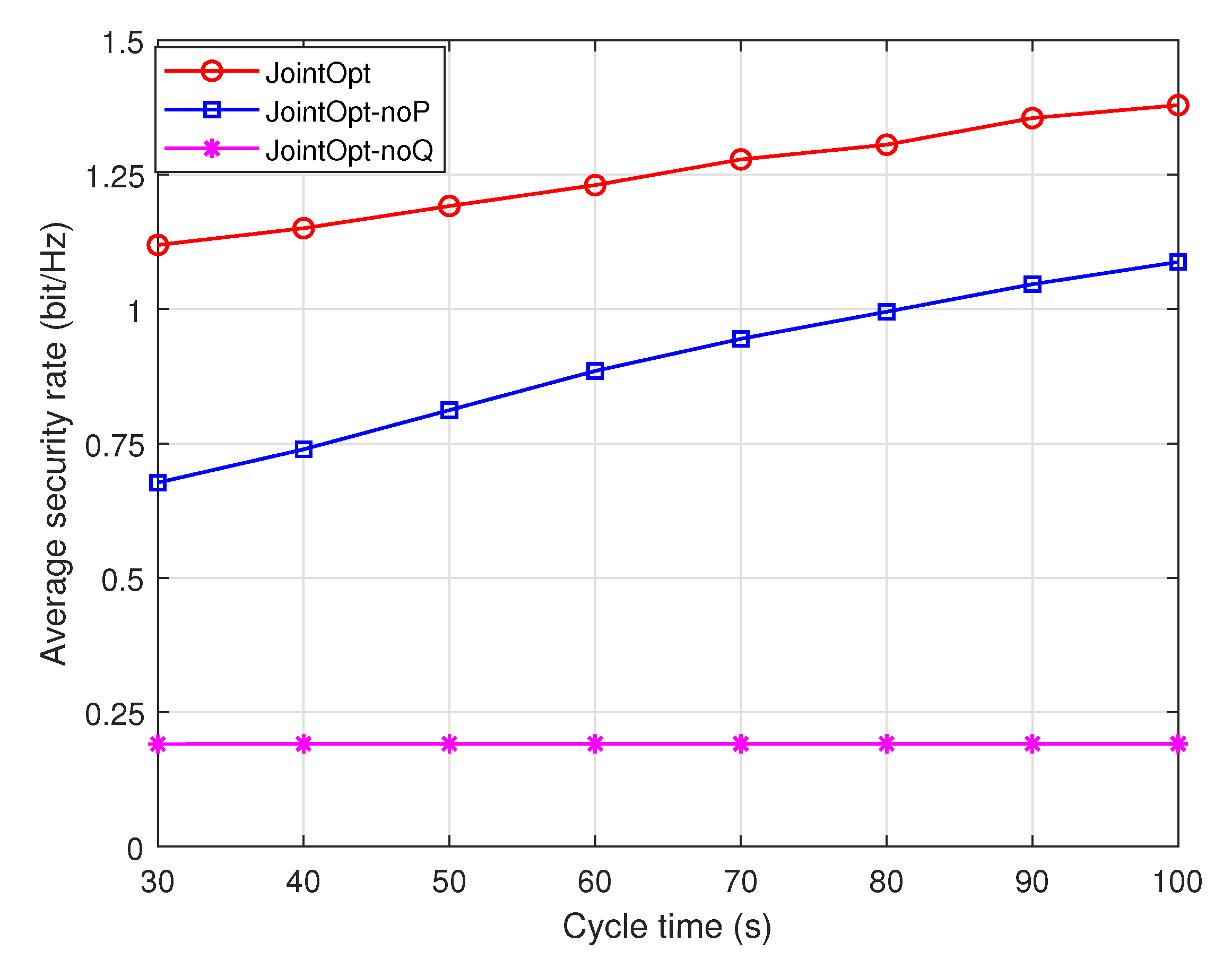1. Introduction
With the growing number of intelligent mobile devices, computing intensive applications such as video calling and virtual reality are becoming more common. However, while providing convenience, mobile devices also have the disadvantage of limited computing resources, which makes it a challenge to provide a high level of experience quality. Mobile edge computing (MEC) has also received widespread attention [
1]. Mobile edge computing significantly reduces network overhead and task execution delay [
2]. Traditional network edge servers are located in base stations all over the communication network. However, fixed base stations still have drawbacks such as limited coverage and severe link loss.
Unmanned aerial vehicles (UAVs) have the characteristics of small size, low cost, rapid deployment on demand, and high-probability air-to-ground line-of-sight (LOS) link, which produces high channel gain in the communication system. Therefore, a large number of studies considered introducing UAVs equipped with computing equipment into mobile edge computing networks to assist ground users in completing computing tasks. Hu et al. [
3] established a UAV-assisted mobile edge computing system. The UAV provides computing services for multiple users in the form of orthogonal multiple access. Zhang et al. [
4] studied the computational efficiency of a UAV MEC system and maximized the computational efficiency by jointly optimizing the offloading time, CPU frequency, user transmit power, and UAV trajectory. Yu et al. [
5] minimized the service delay of all IoT devices and the weighted sum of UAV energy consumption by jointly optimizing UAV location, communication, computing resource allocation, and task splitting decisions. In the research of Shang et al. [
6], the ground computing server and the computing UAV provide computing resources for the ground terminal at the same time. To minimize the total energy consumption of the ground terminal, user scheduling, uplink power control, channel allocation, computing task allocation, and the 3D layout of UAVs are jointly optimized. Kumar et al. [
7] proposed a drone assisted distributed routing framework focusing on quality of service provision in IoT environments (D-IoT). The aerial drone mobility and parameters are modeled probabilistically, focusing on highly dynamic flying ad hoc networks environments. A comparative performance evaluation attests to the benefits of the proposed drone-assisted routing framework. Kumar et al. [
8] developed a complete communication framework for quality of service provisioning in UAV-assisted aerial ad hoc networking (QSPU) based on the aerial ad hoc mobility model and service parameters. Jha et al. [
9] presents a noble, innovative idea for designing and developing a blended-wing-body (BWB)-based configuration system for UAVs, especially for next-generation high-speed drone use cases.
Although UAVs assist ground users in completing computing tasks, which greatly reduces computing delays, the process of users offloading computing data from UAVs also has the risk of data leakage, which brings new challenges to the security performance of mobile edge computing systems. Zhou et al. [
10] studied the physical layer security of UAV base stations transmitting confidential information to multiple information receivers with the assistance of UAV jammers. By formulating UAV trajectory planning and power control schemes, the minimum average secrecy rate of all receivers was maximized. Zhou et al. [
11] used full-duplex legitimate UAVs and non-offloading ground users to transmit jamming signals in order to resist the stealing of the offloading task content by multiple aerial eavesdropping UAVs. In addition, they designed a low-complexity iterative algorithm to maximize the security capacity of the system. Xu et al. [
12] studied a dual UAV-assisted mobile edge computing system in which one UAV is used to help the ground terminal equipment computing offloading tasks, and the other is used as a jammer to suppress malicious eavesdroppers. However, two UAVs can complete only one computing and jamming task, and there are limitations to the improvement of system performance.
In addition, the battery capacity of UAVs is limited, which greatly limits the continuous operation time of the system. Zeng et al. [
13] established a propulsion power consumption model of a rotary-wing UAV and jointly optimized the trajectory of the UAV and communication time allocation between each ground node to meet the communication throughput requirements of each ground node. In addition, the total energy consumption of the system was minimized. Zhang et al. [
14] studied the energy efficiency of a NOMA-based UAV MEC system, mathematically evaluated the energy cost of the system by establishing a utility function, and designed a joint optimization scheme to minimize the energy cost. Zhang et al. [
15] studied the task offloading problem in UAV-assisted MEC. To balance user utility and UAV energy consumption, a matching game algorithm with a bilateral preference list was proposed to save energy.
Although research on UAV-assisted mobile edge computing systems has been relatively comprehensive, few studies have considered the system security rate and system energy efficiency at the same time. Although Hua et al. [
16] established a system secrecy energy efficiency model and maximized it by jointly optimizing the UAV’s trajectory, transmission power, and user scheduling, they only studied the UAV base station communication system.
Therefore, this paper establishes a MEC system model based on a multi-functional UAV in which the UAV can switch between the auxiliary computing UAV and active jamming UAV according to the channel conditions. By considering both security and energy consumption issues at the same time, with the goal of maximizing the security energy efficiency of the system, the user scheduling, UAV trajectory, uplink power, and offload task volume are jointly optimized to improve the security energy efficiency performance of the system. Compared with previous studies, the models used in this study are quite different with different constraints, and the algorithm solution ideas are similar, but the differences in models and constraints also make the algorithms different.
The main contributions of this work are summarized as follows:
We propose a MEC system model based on multi-functional UAVs. Two UAVs with both computing and jamming functions cooperate as ground sensor nodes to provide a safe unloading environment and computing services, and UAVs can switch roles between auxiliary computing UAVs and active jamming UAVs according to their geographical locations in different time slots. Under the premise of considering the system energy efficiency, the mathematical model of the communication system security energy efficiency is established. The system security energy efficiency is maximized through the joint optimization of user scheduling, UAV trajectory, uplink transmission power, and computing task allocation in the system.
In order to deal with the complex non-convex problem, we divide the original problem into two sub-problems. However, the sub-problems with non-convex and fractional objectives are still difficult to deal with. Therefore, the sub-problem is converted into a convex form by applying SCA technology, and the Dinkelbach algorithm solves the fractional problem in an iterative manner. For the solution of two sub-problems, we introduce the BCD method to solve the sub-problem iteratively in an alternate manner until the algorithm converges.
The system SEE performance and security rate performance of the proposed scheme are verified through simulation, and the UAV trajectory and user scheduling after joint optimization are displayed and analyzed. The comparison of different optimization schemes in the simulation results shows the effectiveness of the proposed joint optimization scheme.
2. System Model
Figure 1 depicts a model of a multi-UAV-assisted mobile edge computing system. There are two UAVs in the system, both equipped with transceiver communications and computing devices, which are both capable of assisting in computing and sending signals. According to the channel conditions of its own location, the UAV chooses to act as an auxiliary computing UAV or a friendly jamming UAV, but both kinds of UAVs must exist in the same time slot. Among them, the auxiliary computing UAV is responsible for receiving part of the computing tasks offloaded by
L ground nodes to help it complete the calculation work, while the friendly jamming UAV is responsible for sending jamming signals to resist the threat of
ground eavesdropping nodes. In addition, to obtain a more essential relationship between system indicators and system performance, it is assumed that the positions of ground sensor nodes and eavesdropping nodes are fixed, and the two UAVs know the location information of ground nodes and other UAVs.
Table 1 describes the meaning of the symbols used in this document.
2.1. Channel Model
In this model,
L ground legal sensor nodes are distributed in an area, and a three-dimensional Cartesian coordinate system is established with the lower left boundary point of the area as the origin. Let the coordinate of the
lth ground sensor node
be
, and let the coordinate of the
kth ground eavesdropper
be
. To record the position change of the UAV within the cycle time, the entire cycle time
T is discretized into
N equal time slots, satisfying
, where
is the length of the unit time slot. Since
is small enough, it is assumed that the UAV is at a fixed position in each time slot [
17]. In addition, it is assumed that the flight height of the UAV is fixed as
H, where it can avoid collisions with buildings on the ground. By setting the position coordinates of the UAV in each time slot, the trajectory of the UAV can be approximated as a line segment connected by
N discrete points, and the position of UAV
in the
nth time slot can be expressed as
with
. Then, the trajectory of the UAV needs to satisfy the following constraints:
where the constraints in (1) indicate that the maximum distance of the UAV within time length
is limited by the maximum flight rate
of the UAV, (2) and (3) restrict the start and end position coordinates of each UAV,
represents the initial position of
, and
represents the termination position of
. In addition, due to the small size of the UAVs, collisions between UAVs are ignored.
The study selects a relatively simple path-loss model close to the actual situation, so it is assumed that the Doppler effect caused by high-speed movement can be perfectly compensated, and the two channels other than the ground–ground link are regarded as line-of-sight links, which satisfies the free-space loss model. Therefore, the channel power gain of the link between the ground sensor node and auxiliary computing UAV in the time slot can be expressed as
where
is the channel power when the distance is referenced
, and
indicates the distance between the two nodes in the
nth time slot. Similarly, the channel power gain of the link between jamming UAV
and ground eavesdropping node
in the
nth time slot is
where
represents the distance between the jamming UAV and the eavesdropping node in the
nth time slot. The channel power gain of the air–air link of the two UAVs in the
nth time slot can be expressed as
where
represents the distance between the two UAVs in the
nth time slot. Ground sensor node
and the eavesdropping node
obey Rayleigh fading, and the channel gain is
where
denotes the Rayleigh fading coefficient, which obeys the exponential distribution of the unit mean, and
denotes the distance between two ground nodes.
2.2. Secrecy Rate Model
In this study, a time-division protocol based on time-division multiplexing is used, where each time slot
is divided into
L subtime slots and assigned to each ground sensor node in sequence. Defining the time allocation variable as
, the offloading duration of the ground sensor node
in the
nth time slot can be expressed as
. To ensure the rationality of the time allocation variables,
shall meet the following constraints:
In addition, the power of the UAV to send the jamming signal is defined as
, and
. Define the offloaded transmission power of the ground sensor node
in the
nth time slot as
and satisfy the following constraints:
where
denotes the maximum transmit power of the UAV. The transmission rate between the ground node
and the auxiliary computing UAV in the
nth time slot can be expressed as
where
denotes the Gaussian white noise at the receiver, and
denotes whether
in the
nth time slot is working in the auxiliary computing mode;
denotes that
in the
nth time slot is the auxiliary computing UAV, and
is the active jamming UAV.
denotes that
in the
time slot is the active jamming UAV, and
is the auxiliary computing UAV.
Similarly, the transmission rate between eavesdropper
and ground node
in the
nth time slot is expressed as
In this study, the secure transmission rate of each link is defined by the difference between the transmission rate of legal links and illegal links. Then, in the
nth time slot, the uplink transmission rate of sensor node
is expressed as
where
denotes the larger value in 0, and
x,
.
2.3. Edge Computing Model
Let
denote the number of CPU cycles required to calculate 1 bit of data at the
lth sensor node, and let
denote the number of bits that the
lth sensor node completes the calculation locally in the
nth time slot. The following constraints are met:
where
denotes the maximum CPU frequency of sensor node
.
Assume that the computing UAV executes the computing task immediately after receiving each bit of data and must complete the task within its assigned data upload time
. Since the amount of data in the calculation results is far less than the amount of data actually unloaded [
18], the time for retrieving the calculation results is ignored here. The computing power of the computing UAV should satisfy the following constraints:
where
B denotes the channel bandwidth,
indicates the number of CPU cycles required for the UAV to calculate 1 bit of data in the auxiliary computing, and
indicates the maximum CPU frequency of the UAV to ensure that the total number of CPU cycles required for UAV calculation in each time slot does not exceed its maximum computing power.
is defined to represent the minimum amount of data required by the
lth sensor node in each time slot, so the following constraints should be satisfied:
2.4. Energy Consumption Model
UAVs can be divided into fixed wing UAVs and rotary wing UAVs according to their mechanical structures [
19]. The propulsion energy consumption generated by UAV flight is far greater than the communication energy consumption and computing energy consumption, so only the propulsion energy consumption of UAV flight is considered, and other energy consumption is ignored. The rate of
in the
nth time slot is expressed as follows:
The model adopts a rotor UAV, and the total propulsion energy consumption of
in the whole cycle time can be expressed as [
20]
where
and
are the drag power and induced power in the hovering state, respectively;
is the blade tip angular velocity of the UAV;
is the average rotor induced velocity of the UAV in the hovering state; and
and
s are the fuselage resistance ratio and rotor firmness, respectively.
2.5. Problem Description
The secrecy energy efficiency is defined as the ratio of the sum of the minimum secret rate of each node of the system to the total energy consumption of the UAV. To maximize the secrecy energy efficiency (SEE) of the system, the time allocation variables, UAV trajectory, uplink transmission power, and local computing data volume are jointly optimized. This study also considers the mobility constraints, uplink transmission power constraints, time allocation constraints, computing power, and task volume constraints of two UAVs.
The optimization problem (P1) is described as follows:
where
, respectively, represent the time allocation variables, UAV trajectory, uplink transmission power, and local calculated data volume to be optimized.
Solving problem (P1) has the following difficulties: (1) The objective function of the problem is not smooth at zero. (2) The objective function is a fractional non-convex function. (3) There are a large number of optimization variables and tight coupling between variables. (4) Multiple constraints are non-convex with respect to the optimization variables.
3. Joint Optimization Algorithm
A block coordinate descent (BCD) algorithm with an update rate is proposed to solve the coupling problem between variables. The successive convex approximation (SCA) (
Appendix A) technique and Dinkelbach algorithm [
21] are applied to solve non-convex function and fractional optimization problems. The problem that the objective function is not smooth at zero can be solved by setting
. Let
be the set of all optimization variables; then, variables except trajectory can be expressed as
. Problem (P1) is decoupled into optimization of
and trajectory optimization of
and solved alternately until the algorithm converges.
3.1. Optimization of
For a given UAV trajectory
, the optimization problem of
can be established as follows:
where
. Since the propulsion energy consumption of the UAV is independent of the node time scheduling, transmission rate, and computation task amount,
is a constant. We introduce slack variables
,
,
,
,
and rewrite the original problem as follows:
where
and
, independent of the optimization variables of the sub-problems in this section, are constants.
Due to the introduction of slack variables, the solution obtained by problem (P2.1) is the lower bound of the optimal solution of the original problem. After
r iterations, the time scheduling and transmission power of node
in time slot
n are defined as
and
, respectively. Equations (17d) and (17e) can be rewritten as follows:
To convert the constraints in (18) into convex constraints, the second order cone (SOC) method [
22] is applied, and two convex constraints in (19) are obtained, which are expressed as follows:
where
,
.
Applying the continuous convex optimization approximation algorithm to the non-convex constraints in (17g), the following expression can be obtained:
where
,
.
With the above mathematical approximation, problem (P2.2) can be rewritten as follows:
Thus far, (P2.2) can be solved with the CVX tools.
3.2. UAV Trajectory Optimization
Given time schedule
of sensor nodes, transmission power
, and local computation task
, the trajectory optimization sub-problem of the UAV can be expressed as follows:
By introducing the auxiliary variables
, the original problem can be rewritten as follows:
where
.
For the constraints in (22e), regarding
as a whole, suppose
. The right-hand function of (22e) is a concave function about
, and its upper bound can be obtained by the first-order Taylor expansion at this point. Let the trajectory of the UAV in the
nth time slot after
r iterations be
. Expression (22e) can be transformed into the following convex constraints:
where
and
.
Likewise, applying continuous convex optimization approximations to
and
in (22f), their non-convex lower bounds are obtained as follows:
Then, (22f) can be replaced by (25).
To solve the non-convex problem in (22g), introduce auxiliary variables
and replace it with (26).
The following convex constraints can be obtained by applying first-order Taylor expansion to the right side of the two equations:
Similarly, (22h) can be approximated as
After the above approximation, problem (P3.1) can be rewritten as follows:
Problem (P3.2) can be further solved by Dinkelbach’s algorithm. First,
is defined as the maximum value of the system SEE, and
. Problem (P3.2) can be equivalent to iteratively solving the following problem:
Problem (P3.3) can be solved with the CVX tools. The logic of the algorithm is shown in Algorithm 1. Due to the introduction of slack variables, the result obtained from the solution is the lower bound of the original problem.
| Algorithm 1 Trajectory Planning Algorithm for Problem (P3). |
- 1:
Initialization: Initial trajectory of the base station UAV is , initial value of energy efficiency , maximum threshold , and number of iterations . - 2:
Solve problem (P2.3) given UAV trajectory and system secret energy efficiency value , and obtain optimal solutions , , and . - 3:
Calculate . If , then the algorithm converges, obtains the optimal solution, and outputs , , . Otherwise, continue with steps 4–5. - 4:
Make , update parameters , and update UAV trajectory . - 5:
Update the number of iterations . Then, execute step 3 again to check whether the algorithm converges.
|
3.3. Overall Algorithm Description
To solve problem (P1), the updated-rate assisted block coordinate descent algorithm is applied. The sub-problems in the previous two sections are solved alternately, and the optimal solution of the original problem is obtained. The overall idea is as follows: decouple the original problem into two sub-problems: variable optimization and trajectory optimization. Then, fix one set of variables to solve sub-problems (P2.2) and (P3.3) alternately. The optimal solution is used as the reference value for the next iteration.
The overall description of the joint optimization algorithm is shown in Algorithm 2.
| Algorithm 2 Joint Optimization Algorithm for Maximizing Energy Efficiency |
- 1:
Initialize variables , , , and . Set the minimum error value . Let the number of iterations , update rate , and update factor . - 2:
Given conditions, use the continuous convex optimization approximation algorithm to solve problem (P2), obtain optimal solutions , , , and let , , . - 3:
Given , , and , Algorithm 1 is used to solve problem (P3), obtain the optimized relay UAV trajectory , and let . - 4:
Update the number of iterations , . - 5:
Calculate the increment of the target value . If , then the algorithm converges and ends. Otherwise, continue with steps 2–4. - 6:
Output the optimized solution , , , , and the maximum secret energy efficiency.
|
In Algorithm 2, each sub-problem can be approximated as a linear problem by first-order Taylor expansion. Then the interior point method is used to solve problems (P2), and the computational complexity is
, where
represents the number of decision variables [
16], and
indicates iteration accuracy. Similarly, the computational complexity of questions (P3) is
, where
C represents the number of iterations for the update of
in Algorithm 1. Therefore, the overall computational complexity of Algorithm 2 is
[
23].
Statements (P2.2) and (P3.3) are the approximate problem of the original sub-problems. Therefore, we prove that Algorithm 2 can converge as follows. Define
where
are values of the optimal solution in Problems (P2.2) and (P3.3), respectively based on
. In Step 2 of Algorithm 2, it follows that:
where (a) holds because the first-order Taylor expansions in (19) are tight at the given local points, respectively; (b) holds since that given
, the optimal solution
is obtained by solving Problem (P2.2); (c) holds because the optimal solution of (P2.2) is lower bounded by (P2) at
. According to the inequality above, although only one approximate optimization problem (P2.2) is solved, the target value of Problem (P2) is still non decreasing after each iteration. Second, in step 2 of Algorithm 2, given
, it follows that:
where (d) holds, since that by given
, (P2) can be handled with optimal solution
. Then, in step 2 of Algorithm 2, for the given
, it follows that:
Then, in step 3 of Algorithm 2, for the given
, it follows that:
Based on the above inequality, we obtain:
It indicates that the target value of Problem (P1) is non decreasing after each iteration of Algorithm 2. Since the objective value of the problem (P1) is bounded by a finite value, Algorithm 2 must converge to a stable point.
